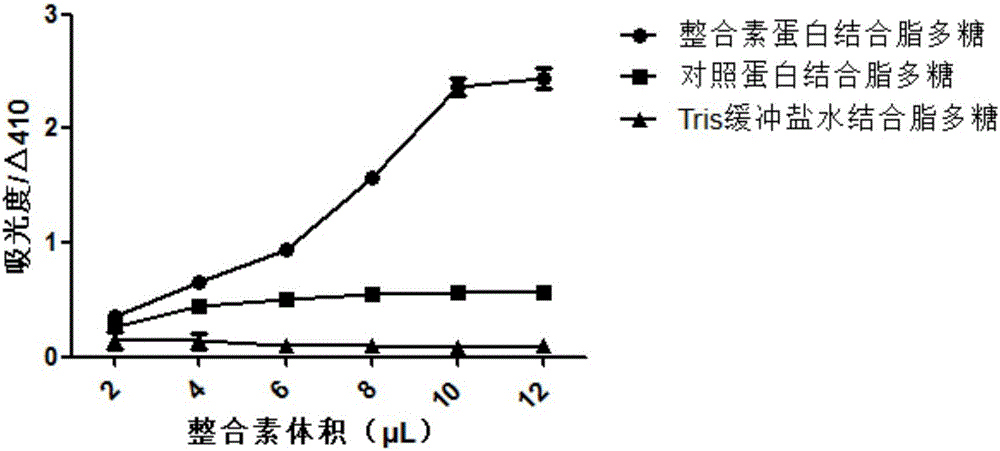Apostichopus japanicus ITGB gene, coding protein, cloning method of ITGB gene and construction method of recombinant apostichopus japanicus ITGB genetically engineered bacteria
A technology of genetically engineered bacteria and cloning method, which is applied to the construction of recombinant japonicus ITGB genetically engineered bacteria, japonicus ITGB gene, encoded protein and its cloning, which can solve problems such as the loss of japonicus aquaculture and achieve the effect of low cost
- Summary
- Abstract
- Description
- Claims
- Application Information
AI Technical Summary
Problems solved by technology
Method used
Image
Examples
specific Embodiment 1
[0049] ITGB gene cloning and sequence analysis
[0050] a. Through the EST (Expressed Sequence Tag) analysis of the cDNA library of Apostichopus japonicus japonicus japonicus in the early stage, a number of EST sequences encoding ITGB genes were found (PengjuanZhang, ChenghuaLi, LinZhu, XiurongSu, YeLi, ChunhuaJin, TaiwuLi. PlosONE2013.8(9):e73506.), a sequencing analysis of one of the EST clones showed that the clone encoded a partial fragment of A. japonicus ITGB;
[0051] b. RACE primer design: Design RACE nested primers for the partial ITGB fragment described in step a above: 3' upstream specific primer 1: GGTTCATTGTCAAATCGGAG, 3' upstream specific primer 2: GATTACGTCGCTCTGGTCCA; 5' downstream specific primer 1: CCAACAATTCTGCAACCTCCG,
[0052] 5' downstream specific primer 2: TGCAACAAGGGGCACTTGGAG, amplify 3' adapter primer Adaptor3: TACCGTCGTTCCACTAGTGATTT, amplify 5' adapter primer Adaptor5: CATGGCTACATGCTGACAGCCTA;
[0053] c. RACE amplification to obtain the full-len...
specific Embodiment 2
[0060] Full-length cloning of ITGB gene and construction and expression of recombinant protein
[0061] a. Extraction of total RNA: Take 1.0 mL of sea cucumber body cavity fluid, centrifuge at 800 g for 5 min, collect blood cells, add 1.0 mL of Trizol reagent (purchased from Takara Company), shake and mix, leave at room temperature for 5 min, then add 0.2 mL of chloroform, shake and mix , stand at room temperature for 10 minutes, centrifuge at 12,000 g at 4°C for 15 minutes, draw the supernatant into an EP tube, add an equal volume of isopropanol to the supernatant, mix well, let stand at room temperature for 5 minutes, centrifuge at 4°C, 12,000 rpm for 10 minutes, remove For the supernatant, add 1 mL of ethanol aqueous solution with a mass percentage concentration of 75% to the precipitate, centrifuge at 4°C and 12000 rpm for 5 min, remove the supernatant, let the precipitate stand for 5-10 min, add 20 μL of RNase-free water to obtain the RNA extract;
[0062] b. cDNA synthes...
specific Embodiment 3
[0068] Purification and renaturation of recombinant proteins
[0069] a. Protein purification: After collecting the bacteria by centrifugation, resuspend the bacteria with 10 mL of inclusion body washing solution per 100 mL of culture, sonicate the bacteria, centrifuge at 12000 rpm for 10 min, resuspend the precipitate with 5 mL of inclusion body solution, and ultrasonically break until the solution is basically After becoming clear, centrifuge again at 15000rpm for 20min, and absorb 1mL of Ni-NTASefinose TM Resin (Shanghai Sangong, No.: BSP033) was applied to the column, washed twice with sterile water, and then equilibrated once with inclusion body solution. The supernatant was mixed with the Ni-NTASefinose on the column before TM Resin mixed, 4 ℃ mixed for 1h. The collected effluent was applied to the column twice, and the medium was washed with miscellaneous protein washing solution, 10mL each time, and after elution for 10 times, 0.6mL denatured protein eluent was added...
PUM
| Property | Measurement | Unit |
|---|---|---|
| molecular weight | aaaaa | aaaaa |
Abstract
Description
Claims
Application Information
 Login to View More
Login to View More - R&D
- Intellectual Property
- Life Sciences
- Materials
- Tech Scout
- Unparalleled Data Quality
- Higher Quality Content
- 60% Fewer Hallucinations
Browse by: Latest US Patents, China's latest patents, Technical Efficacy Thesaurus, Application Domain, Technology Topic, Popular Technical Reports.
© 2025 PatSnap. All rights reserved.Legal|Privacy policy|Modern Slavery Act Transparency Statement|Sitemap|About US| Contact US: help@patsnap.com



